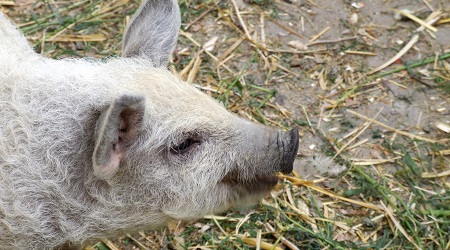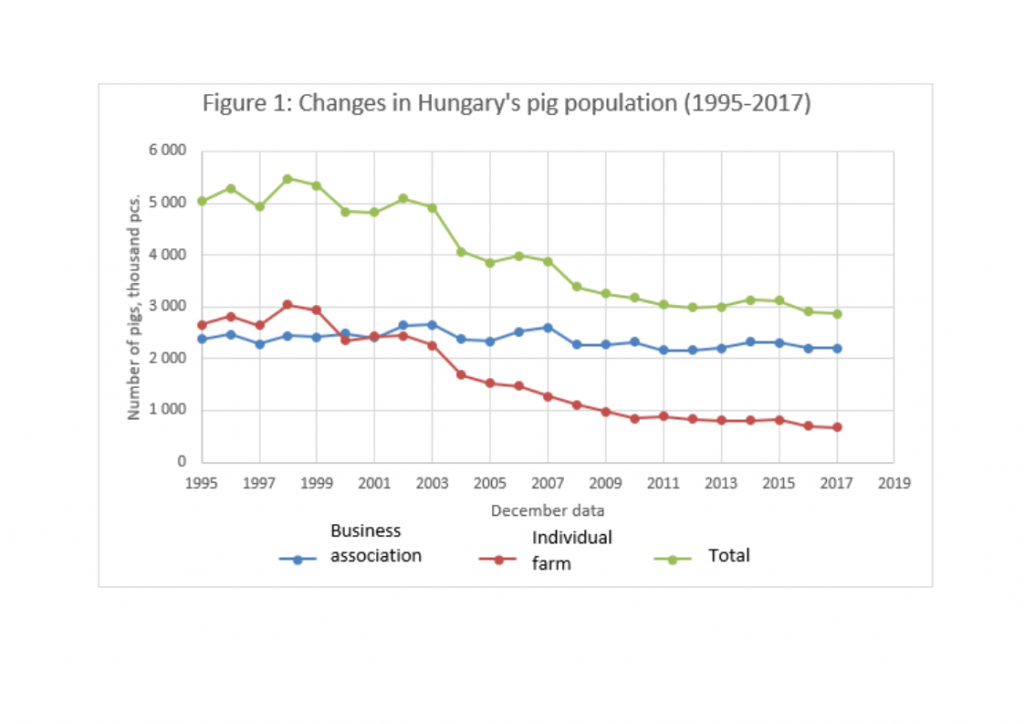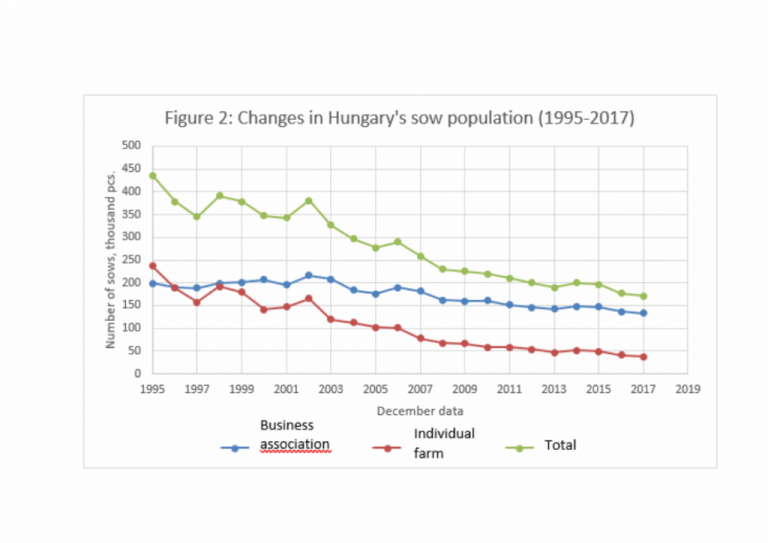
10/04/2018
Our pig population has fallen to a third in the last nearly 30 years, being the largest decline compared to the number of cattle and poultry.
According to the CSO data of 2017, we kept 2.87 million pigs, including 171,500 sows were counted. Needs of the domestic market had to be complemented with import. If we look at the data on stock changes (Figures 1 and 2), it can be clearly seen that the number of pigs kept by business organizations has decreased only slightly over the last 20 years, following the normal market fluctuation.
Changes in Hungary's pin and sow population


The number of sows has decreased due to the acceleration of breed change (the spread of super-prolific hybrids), since we can also produce the amount of fattening pigs that the market takes up with fewer sows.
In the case of individual farms (household, farmers), from the beginning of the 2000s, we can see a continuous “discouragement” in pigkeeping, which is the real cause of the decline in the stock of pigs and stocks in Hungary. What led us here? Increase in feed prices, reduced fattening pig prices, lack of competitiveness, ageing of pig keepers, the shift of the young generation from traditional agriculture, the tightening of environmental requirements, the urbanization of the countryside. That is, several factors have hindered the survival of ‘white small farms’.
In order to reverse this downward trend, many changes have been made over the years. From January 2016 onwards, instead of 27%, 5% VAT is applicable to pork – with the exception of meat unfit for human consumption –, thereby reducing the proliferation of black trade. This is why the unique marking of sows has been introduced and they also receive continuous support. To achieve the High Quality Pig Trademark, one needs to comply with a comprehensive product certification system. It guarantees the sustainability of the product, the process of its production and, if necessary, the origin of the product can be checked.
Thus, the support side of production can be regarded as realized, the solution shall be sought in order to achieve efficiency. The economy of production does not necessarily mean cheap production at the expense of quality.
Many plants mean travelling to times before the 70s and 80s
They need investment, although modern automated systems are increasingly used based on Danish, Dutch and American examples. These, like all innovations, are costly and require well-trained professionals. There is very few farms that apply liquid feeding systems, although this technology can save significant costs. We are not prepared for the use and reception of industrial by-products, since 30-40 years ago we were not even aware of them.
We haven’t been able to talk about domestic genetics for nearly 20 years. The improvement of breeding is mostly based on breeding animals imported from the West. MFSE (Hungarian Purebred Pig Breeders’ Association) was established to promote a uniform, rule-based breeding procedure and its enforcement. In this way, the use of self-produced breeding animals with reduced natural indicators can be reduced.
In most cases, the success of breeding is undermined by basic factors, such as the quality of temperature, air, water, feed or litter.
In the absence of their own production area, producers become vulnerable to the quality and price of grain, and in terms of output, manure placement, which is subject to strict rules, may cause a headache. When discussing the issue of feed, it is important to mention the constant price movement of soy and its genetically modified origin. To address this, many feed consultancy firms provide free or discounted laboratory testing of products with a strong emphasis on accurate content and mycotoxin values.
Our export of live pigs targets China in addition to the neighbouring countries thanks to the high quality meat production generated by cereal-based feed. In the case of pork, however, besides Polish pigs, Slovak, German and Dutch imports have also been present, which could be mitigated by establishing the required health care regulations.
The collaboration of all players in the product chain, the coordination of fattening, breeding and slaughterhouse organizations is essential for the efficient operation of the system.
But a competitive and efficient market cannot be built solely on support. To successfully get out of the difficulty, the needs of the domestic and export markets need to be assessed, and we shall adjust to it, not the other way around. In addition to the products available to everyone, the demand for domestic premium products should be preserved through the development of technology. In addition to improving natural indicators, clarifying the long-standing protein policy and issue and developing cheap and safe alternatives is another step, including the reuse of animal proteins. Apart from the Bonafarm Group, there is no other organization that can build its market from breeding to meat processing with a significant share. There is also a need for modern slaughterhouses, since the new slaughterhouse in Mohács is currently capable of cutting around 1 million pigs. In order to achieve this, it is important to have the supporting role of a domestic professional organization with applicable and up-to-date knowledge or perhaps a central performance testing apparatus that can support farming in feeding or even genetic knowledge and give an independent opinion.
The history of domestic mangalica can serve as an example, which was reduced in the number of sows from 18,000 sows around the world war to around 500 sows, but has increased again to 10,000, and an association having up-to-date knowledge and plans has been formed to maintain it.
With the establishment of the National Association of Mangalica Breeders, a unified, regulated system of production was established to protect the interests of the members and help their development in view of the demand. The association is an official breeding organization recognized by the state, which controls the production sites while also taking part in the preparation of regulations and subsidies. By also marketing the breed, they try to bring back mangalica to public knowledge and to the kitchen table as Hungaricum.
Mangalica products are considered to be curiosity and premium, so they have also entered the Spanish, Swiss, Russian and Japanese markets, laying the foundations for our pig breeding sector. The unified production policy of mangalica exemplifies that Hungarian white meat industry has a future too, which can be successful if we cooperate.
“But we don’t know yet, we don’t yet understand where we will arrive” (Karthago band: Apáink útján/Following the road of our fathers)
Created by:
- Edit Árendás Agricultural Engineer, Commercial manager for raw materials
- Tamás Földes Angricultural Engineer, Dairy Engineer, Veterinary Microbiologist, Sales Manager
- Gergely Bakti Agricultural Engineer, Consultant,
all of them being colleagues of NeoCons Plus Kft.







